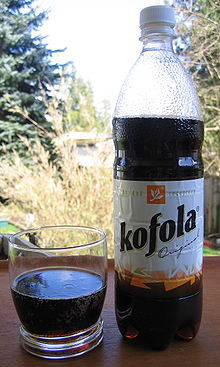Slovak cuisine
The Slovak cuisine is the national cuisine of Slovakia . Due to historical circumstances, it has been influenced by the surrounding countries, particularly the Hungarian , Austrian and Czech cuisine. Traditionally, Slovak cuisine is based on the use of meat, potatoes, vegetables (especially sauerkraut ) and dairy products. This is partly due to the harsh climatic conditions in many of the country's mountains.
Dishes and specialties
Below is a (not complete) selection of dishes.
Soups
A traditional Slovak soup is the sauerkraut soup ( kapustnica ). It consists of soured white cabbage , smoked meat , dried mushrooms and plums, sausage, a little flour and sour cream . Other typical soups are bean soup ( fazuľová polievka ), garlic soup ( cesnaková polievka ), lentil soup ( šošovicová polievka ), brim soup ( demikát ), beef and chicken soup and goulash soup .
Main courses
In the Slovak cuisine is the use of cams ( halušky ) typical in Zipserdeutschen also called Haajaknetchen. The national dish derived from this is called Bryndzové halušky (Brimsennocken), in which the nocken are served with bryndza (a type of sheep's cheese) and bacon. Another well-known dish is "Sauerkrautnocken" ( strapačky or kapustové halušky ), of which there are a number of variants in the different regions of Slovakia . Typical of Slovakia are also potato cake (lokše) and roasted meat dishes such as roast goose and meat dishes, such as black pudding (jaternica) , brawn (tlačenka) and Sulz (huspenina) .
The traces of the Hungarian and Austrian cuisine are unmistakable; Goulash and Wiener Schnitzel are common main courses. Another Czech dish popular in Slovakia is sviečková (sirloin).
Other dishes:
- Bryndzové pirohy ( Brimsen pierogies )
- Granadír ( Grenadier March )
- Parené buchty ( steamed noodles )
- Vyprážaný syr (breaded and fried cheese)
- Zemiakové placky ( potato pancakes , potato pancakes)
Desserts
Various types of strudel , yeast cakes and Buchteln are part of Slovak cuisine. Apart from everyday consumption, the desserts are especially prepared during Christmas and Easter.
- Bábovka ( gugelhupf )
- Bratislavské rožky (Pressburger Kipferln )
- Medovníky ( honey cake )
- Palacinky ( pancakes / pancakes )
- Makové šúľance (poppy seed noodles)
- Trdelník (Baumkuchen)
- Žemľovka ( funeral pyre )
A typical salty pastry is pogatschen ( pagáče ).
cheese
There are a number of different types of sheep cheese in Slovakia. The best known is the aforementioned brimsen ( bryndzová nátierka ), which is also used as a spread. Known in Austria under the name Liptauer , it belongs to the so-called šmirkás (in German: smeared cheese ).
Other typical cheeses are:
- Oštiepok , an originally Wallachian hard cheese made from sheep's milk. It is prepared by pinching the fresh sweet cheese into a wooden round shape. After standing, it is lowered into salty warm water until the salt has completely penetrated the cheese. Finally it is dried. There is a similar Polish cheese called Oscypek , but it differs in the ratio of ingredients, the way it is made and its characteristics.
- Parenica , a semi-hard, non-ripening, semi-fat and (usually) smoked sheep's cheese that gets its "S" shape by being rolled up in the opposite direction. This cheese is the specialty of the Pohronie region(" Grantal ").
- Korbáčiky (Sg. Korbáčik , German for "little scourge"), a braided cheese from the Orava region( Arwa ). It is available both smoked and unsmoked.
beverages
Žinčica, made from sheep's milk, comes from the mountainous areas .
Apart from that, beer is a popular drink in Slovakia. Well-known local brands such as Corgoň , Smädný mních , Stein , Šariš , Topvar and Zlatý Bažant have for the most part been taken over by international groups. To this end, numerous small breweries emerged from the late 2000s : at the beginning of 2020 there were a total of 76 small breweries in addition to four medium-sized and large breweries.
Even wine is widespread. Common varieties are produced in the six wine-growing regions in the west and south of the country; The best known of these are the Small Carpathian wine-growing region ( Blaufränkisch , Riesling ) and the Slovak part of the Tokaj wine-growing region.
Specific brandies include borovička ( distilled from juniper berries) and hriatô (mixture of fried bacon, alcohol and honey or sugar). Also slivovitz ( slivovica ) is, among other brandies as marhuľovica (apricot apricot schnapps) jablkovica (apple brandy) or Hruškovica popular (pear brandy) in Slovakia. A typical Slovak herbal liqueur is Demänovka .
The Slovakian grape juice drink Vinea and the Czech Kofola are known as non-alcoholic drinks .
literature
- Ján Babilon: Prvá kuchárska kniha . 1870.
- Vojtech Španko and others: Slovenská kuchárka . Ed .: Osveta. 4th edition. Martin 1982.
- Ľudmila Dullová: Veľká slovenská kuchárka . Ed .: Ikar. 2007, ISBN 80-7118-783-6 .
- Zora Mintalová-Zubercová: Všetko okolo stola I. Ed .: Matica slovenská. Martin 2008, ISBN 978-80-89208-94-4 .
- Zora Mintalová-Zubercová: Všetko okolo stola II. Ed .: Matica slovenská. Martin 2010, ISBN 978-80-8115-013-5 .
- Dr. Marie Hrubá with collective: Naše kuchařka ("Our Kitchen"), Státní zemědělské nakladatelství Praha (State Agricultural Publishing House Prague), 1957 (several editions with different titles, e.g. Kuchařka naší vesnice ["Kitchen of our village"] from 1970)
Web links
- Slovak gastronomy on slovakia.travel
- Description on slovak-republic.org (English)
Individual evidence
- ↑ Slovak gastronomy. Slovak National Tourist Board, accessed March 28, 2020 (Slovak).
- ↑ Spor o oštiepok je zo stola, V4 plánuje žalobu na Komisiu , EurActiv.sk
- ↑ opive.sk: Mapa slovenských pivovarov. Kde všade varia pivo. Retrieved March 28, 2020 (Slovak).




